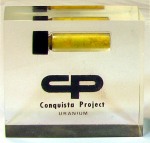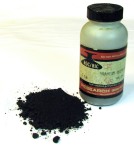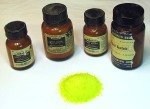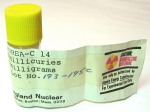Radioactive chemical reagents (and a bit of non-radioactive fake yellowcake) constitute this instalment of my Nuclear Collection feature.
 Depleted uranium metal from United Nuclear. These two rough-hewn triangular slabs weigh in at about 13 g apiece. No idea what Bob Lazar cut up to put these on the market, but they’re not a bad deal while they last. They sport very rough, sharp edges and have to be stored under oil because of the risk of pyrophoric ignition. Uranium fires are a bummer, especially when they occur in your living room.
Depleted uranium metal from United Nuclear. These two rough-hewn triangular slabs weigh in at about 13 g apiece. No idea what Bob Lazar cut up to put these on the market, but they’re not a bad deal while they last. They sport very rough, sharp edges and have to be stored under oil because of the risk of pyrophoric ignition. Uranium fires are a bummer, especially when they occur in your living room.
 Fake yellowcake memento from the Conquista Project. About 20 cm3 of a canary–yellow, non-radioactive powder that resembles a diuranate salt is contained in a small vial embedded in this commemorative plastic paperweight. The Conoco-Pioneer strip mining and milling operations in Karnes County, Texas commenced in 1971, for a time producing most of that state’s uranium.
Fake yellowcake memento from the Conquista Project. About 20 cm3 of a canary–yellow, non-radioactive powder that resembles a diuranate salt is contained in a small vial embedded in this commemorative plastic paperweight. The Conoco-Pioneer strip mining and milling operations in Karnes County, Texas commenced in 1971, for a time producing most of that state’s uranium.
 Real yellowcake, or actually a chemically-pure grade of depleted U3O8 in a 1-lb reagent bottle from Research Organic /Inorganic Chemical Corp. After calcining, this is indeed what most modern “yellowcakes” resemble both in chemistry and appearance. This bottle is a gift from another amateur scientist.
Real yellowcake, or actually a chemically-pure grade of depleted U3O8 in a 1-lb reagent bottle from Research Organic /Inorganic Chemical Corp. After calcining, this is indeed what most modern “yellowcakes” resemble both in chemistry and appearance. This bottle is a gift from another amateur scientist.
 Uranyl acetate reagent bottles. Uranyl acetate is still widely available as an electron-microscopy stain. It’s a beautiful color, and like most uranyl salts, exhibits striking UV fluorescence. The yellow crystals have a faint odor of vinegar. Likely they taste accordingly (although taking uranium internally is generally frowned upon).
Uranyl acetate reagent bottles. Uranyl acetate is still widely available as an electron-microscopy stain. It’s a beautiful color, and like most uranyl salts, exhibits striking UV fluorescence. The yellow crystals have a faint odor of vinegar. Likely they taste accordingly (although taking uranium internally is generally frowned upon).
 Vial of urea labeled with 50 microcuries of carbon-14. C-14 is a weak beta emitter that is best known for its role in carbon dating. Because of the importance of carbon in biological processes (durrrh!), C-14 is also useful as a tracer in research, which is the suspected purpose of this product from New England Nuclear. The label says “Use only as authorized by Atomic Energy Commission,” effectively dating this carbon to 1974 or earlier. Activity is only detectable by removing the lid and holding a Geiger tube over the opening.
Vial of urea labeled with 50 microcuries of carbon-14. C-14 is a weak beta emitter that is best known for its role in carbon dating. Because of the importance of carbon in biological processes (durrrh!), C-14 is also useful as a tracer in research, which is the suspected purpose of this product from New England Nuclear. The label says “Use only as authorized by Atomic Energy Commission,” effectively dating this carbon to 1974 or earlier. Activity is only detectable by removing the lid and holding a Geiger tube over the opening.
 Calibrated bismuth-210 beta sources. Bi-210, or archaically “radium E”, appears in the uranium decay series. The sources actually contain lead-210 (radium D) with a half-life of 22 years in secular equilibrium with the 5-day Bi-210 daughter. The weak betas from Pb-210 are absorbed in the source, while the 1.2-MeV betas from Bi-210 are free to escape. The set is incomplete; present are four sources ranging in activity from 7.73 nCi to 0.364 μCi (measured in 1962).
Calibrated bismuth-210 beta sources. Bi-210, or archaically “radium E”, appears in the uranium decay series. The sources actually contain lead-210 (radium D) with a half-life of 22 years in secular equilibrium with the 5-day Bi-210 daughter. The weak betas from Pb-210 are absorbed in the source, while the 1.2-MeV betas from Bi-210 are free to escape. The set is incomplete; present are four sources ranging in activity from 7.73 nCi to 0.364 μCi (measured in 1962).
 Quarter pound of thorium nitrate. This bottle of Baker ACS-grade reagent is still sealed, preventing radon from escaping and allowing the delicious thorium decay chain to build up. The penultimate thorium decay product, thallium-208, is responsible for one of the most energetic gamma rays found in nature: 2.62 MeV. I use this bottle as a source of 2.62-MeV gamma radiation to calibrate the high end of the energy scale in scintillation spectrometry.
Quarter pound of thorium nitrate. This bottle of Baker ACS-grade reagent is still sealed, preventing radon from escaping and allowing the delicious thorium decay chain to build up. The penultimate thorium decay product, thallium-208, is responsible for one of the most energetic gamma rays found in nature: 2.62 MeV. I use this bottle as a source of 2.62-MeV gamma radiation to calibrate the high end of the energy scale in scintillation spectrometry.
